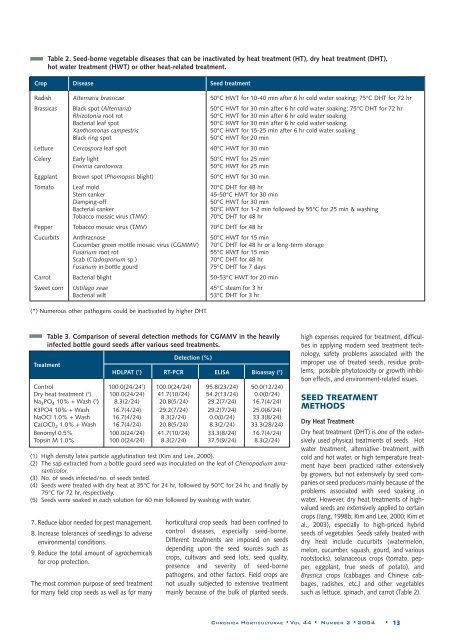Number 2 - 2004 - Acta Horticulturae
Number 2 - 2004 - Acta Horticulturae
Number 2 - 2004 - Acta Horticulturae
Create successful ePaper yourself
Turn your PDF publications into a flip-book with our unique Google optimized e-Paper software.
Table 2. Seed-borne vegetable diseases that can be inactivated by heat treatment (HT), dry heat treatment (DHT),<br />
hot water treatment (HWT) or other heat-related treatment.<br />
Crop Disease Seed treatment<br />
Radish Alternaria brassicae 50°C HWT for 10-40 min after 6 hr cold water soaking; 75°C DHT for 72 hr<br />
Brassicas Black spot (Alternaria) 50°C HWT for 30 min after 6 hr cold water soaking; 75°C DHT for 72 hr<br />
Rhizotonia root rot<br />
50°C HWT for 30 min after 6 hr cold water soaking<br />
Bacterial leaf spot<br />
50°C HWT for 30 min after 6 hr cold water soaking<br />
Xanthomonas campestris<br />
50°C HWT for 15-25 min after 6 hr cold water soaking<br />
Black ring spot<br />
50°C HWT for 20 min<br />
Lettuce Cercospora leaf spot 40°C HWT for 30 min<br />
Celery Early light 50°C HWT for 25 min<br />
Erwinia carotovora<br />
50°C HWT for 25 min<br />
Eggplant Brown spot (Phomopsis blight) 50°C HWT for 30 min<br />
Tomato Leaf mold 70°C DHT for 48 hr<br />
Stem canker<br />
45-50°C HWT for 30 min<br />
Damping-off<br />
50°C HWT for 30 min<br />
Bacterial canker<br />
50°C HWT for 1-2 min followed by 55°C for 25 min & washing<br />
Tobacco mosaic virus (TMV)<br />
70°C DHT for 48 hr<br />
Pepper Tobacco mosaic virus (TMV) 70°C DHT for 48 hr<br />
Cucurbits Anthracnose 50°C HWT for 15 min<br />
Cucumber green mottle mosaic virus (CGMMV) 70°C DHT for 48 hr or a long-term storage<br />
Fusarium root rot<br />
55°C HWT for 15 min<br />
Scab (Cladosporium sp.)<br />
70°C DHT for 48 hr<br />
Fusarium in bottle gourd<br />
75°C DHT for 7 days<br />
Carrot Bacterial blight 50-53°C HWT for 20 min<br />
Sweet corn Ustilago zeae 45°C steam for 3 hr<br />
Bacterial wilt<br />
53°C DHT for 3 hr<br />
(*) Numerous other pathogens could be inactivated by higher DHT.<br />
Table 3. Comparison of several detection methods for CGMMV in the heavily<br />
infected bottle gourd seeds after various seed treatments.<br />
Treatment<br />
Detection (%)<br />
HDLPAT ( 1 ) RT-PCR ELISA Bioassay ( 2 )<br />
Control 100.0(24/24 3 ) 100.0(24/24) 95.8(23/24) 50.0(12/24)<br />
Dry heat treatment ( 4 ) 100.0(24/24) 41.7(10/24) 54.2(13/24) 0.0(0/24)<br />
Na 3 PO 4 10% + Wash ( 5 ) 8.3(2/24) 20.8(5/24) 29.2(7/24) 16.7(4/24)<br />
K3PO4 10% + Wash 16.7(4/24) 29.2(7/24) 29.2(7/24) 25.0(6/24)<br />
NaOCl 1.0% + Wash 16.7(4/24) 8.3(2/24) 0.0(0/24) 33.3(8/24)<br />
Ca(OCl) 2 1.0% + Wash 16.7(4/24) 20.8(5/24) 8.3(2/24) 33.3(28/24)<br />
Benomyl 0.5% 100.0(24/24) 41.7(10/24) 33.3(8/24) 16.7(4/24)<br />
Topsin M 1.0% 100.0(24/24) 8.3(2/24) 37.5(9/24) 8.3(2/24)<br />
(1) High density latex particle agglutination test (Kim and Lee, 2000).<br />
(2) The sap extracted from a bottle gourd seed was inoculated on the leaf of Chenopodium amaranticolor.<br />
(3) No. of seeds infected/no. of seeds tested.<br />
(4) Seeds were treated with dry heat at 35°C for 24 hr, followed by 50°C for 24 hr, and finally by<br />
75°C for 72 hr, respectively.<br />
(5) Seeds were soaked in each solution for 60 min followed by washing with water.<br />
7. Reduce labor needed for pest management.<br />
8. Increase tolerances of seedlings to adverse<br />
environmental conditions.<br />
9. Reduce the total amount of agrochemicals<br />
for crop protection.<br />
The most common purpose of seed treatment<br />
for many field crop seeds as well as for many<br />
horticultural crop seeds had been confined to<br />
control diseases, especially seed-borne.<br />
Different treatments are imposed on seeds<br />
depending upon the seed sources such as<br />
crops, cultivars and seed lots, seed quality,<br />
presence and severity of seed-borne<br />
pathogens, and other factors. Field crops are<br />
not usually subjected to extensive treatment<br />
mainly because of the bulk of planted seeds,<br />
high expenses required for treatment, difficulties<br />
in applying modern seed treatment technology,<br />
safety problems associated with the<br />
improper use of treated seeds, residue problems,<br />
possible phytotoxicity or growth inhibition<br />
effects, and environment-related issues.<br />
SEED TREATMENT<br />
METHODS<br />
Dry Heat Treatment<br />
Dry heat treatment (DHT) is one of the extensively<br />
used physical treatments of seeds. Hot<br />
water treatment, alternative treatment with<br />
cold and hot water, or high temperature treatment<br />
have been practiced rather extensively<br />
by growers, but not extensively by seed companies<br />
or seed producers mainly because of the<br />
problems associated with seed soaking in<br />
water. However, dry heat treatments of highvalued<br />
seeds are extensively applied to certain<br />
crops (Jang, 1998b; Kim and Lee, 2000; Kim et<br />
al., 2003), especially to high-priced hybrid<br />
seeds of vegetables. Seeds safely treated with<br />
dry heat include cucurbits (watermelon,<br />
melon, cucumber, squash, gourd, and various<br />
rootstocks), solanaceous crops (tomato, pepper,<br />
eggplant, true seeds of potato), and<br />
Brassica crops (cabbages and Chinese cabbages,<br />
radishes, etc.) and other vegetables<br />
such as lettuce, spinach, and carrot (Table 2).<br />
CHRONICA HORTICULTURAE •VOL 44 • NUMBER 2 • <strong>2004</strong> • 13
















